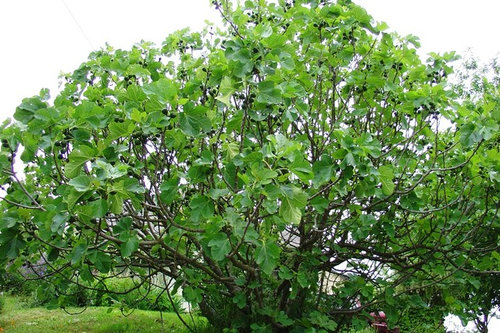Beautiful (possible) Gillette/Croisic Find
Hi All-
I was out last night checking out some local Fig trees, and one that I thought was another 'King' looks very much like the capri fig 'Gillette'. 'Gillette' has quite a history up here, so it would seem fitting. If it is a 'Gillette', it has quite a large profichi crop. I should be able to tell when the fruits ripen.
While Condit and others have said the fruit is insipid, I've heard others describe a perfectly ripe Gillette profichi as "roasted marshmallow." But it MUST be perfectly ripe.
This fig is mentioned in the book (and displayed on the interactive NT Times map), "Renewing America's Food Traditions" by Gary Paul Nabhan, "profiles 93 foods once common in American kitchens but now in danger of disappearing."
Once an ID is more certain, future trades are welcome!


{{gwi:789583}}
Condit's Description:
Croisic (syns. Saint John, Cordelia, Pingo de Mel, Gillette). Described as Croisic by
Solms-Laubach (1882, 1885), Trabut (1901), Leclerc du Sablon (1908), Rixford (1920a),
and Condit (1942, 1947). Described as Saint John or Saint Johns by Wythes (1890b,
1900b), Wright (1895), Eisen (1901), Bunyard and Thomas (1904), Starnes and Monroe
(1907, as Saint Jean Blanc), B. A. Bunyard (1925), 0. T. (1905), Thompson (1925), and
Preston (1951). Described as Cordelia by Eisen (1896, 1901). Described as Pingo de Mel
by Coleman (1887a), Eisen (1901), Thomas (1902), Henslow (1902), Cheffins (1905),
Royal Horticultural Society (1916), and Condit (1921b).
In 1882, Solms-Laubach reported observations both at Croisic and at Cherbourg,
France, of an edible fig which, like the caprifig, had a zone of male flowers inside near
the eye. Three years later he expressed the opinion that Croisic is simply a highly
developed caprifig deprived of the blastophagas which normally inhabit caprifigs. In
July, 1893, Gustav Eisen noticed in the San Francisco market some large yellow figs
shipped from Cordelia, California. He examined the fruit and found "every one with a
fully developed zone of male flowers, fully ripe, and with an abundant, perfectly
developed pollen." Eisen concluded that this fig was possibly identical with the Croisic
described by Solms-Laubach, but he placed it in a special class, the Cordelia, or Ficus
carica relicta. At a meeting of the Royal Horticultural Society, July 8, 1902, Henslow
cited the fig variety Pingo de Mel as an exception to the rule that all edible figs are
female, since its fruit bore stamens.
According to Wythes (1890b), the Saint John, exhibited by Veitch and Sons, Chelsea,
at the Temple Show in London, was a welcome addition to the list of good varieties. In
1900, Wythes expressed the opinion that Pingo de Mel and Saint John were not the
same. However, George Bunyard, also O. T. and Thompson, regarded the two as
identical, and recommended the variety as one of the best for forcing in pots.
Trees of the Croisic are occasionally found in California, especially in the vicinity of
San Francisco Bay. They are also grown in a small way in Oregon under the name
"Gillette," because cuttings were obtained from the Gillet Nursery, Nevada City,
California. P.I. No. 6,952, obtained from Malta as Tin Baitri or Saint John, and Nos.
18,858 and 18,885 of the Chiswick collection, have all proved to be identical with
Croisic.
Tree vigorous and productive; leaves medium to large, mostly 5-lobed; sinuses
medium, narrow; base subcordate.
Profichi medium or above, up to 1-3/4 inches in diameter, pyriform with distinct
neck; ribs prominent, with surface often somewhat corrugated; eye fairly large, with
yellowish-green scales; color greenish yellow; interior white; edible pulp insipid,
lacking in sugar; staminate flowers few, generally lacking in pollen.
Mammoni crop scanty in interior valleys but fair in cool, coastal climates; figs much
the same as profichi.
Mark
Seattle, WA
Here is a link that might be useful: Disappearing Foods: Encouraging a Comeback








loslunasfarms
boizeau
Related Professionals
Barrington Hills Landscape Architects & Landscape Designers · Severn Landscape Architects & Landscape Designers · Jackson Landscape Contractors · Tempe Landscape Contractors · Lees Summit Landscape Contractors · Rochester Landscape Contractors · Roseville Landscape Contractors · Wallingford Landscape Contractors · Yukon Landscape Contractors · Parker Decks, Patios & Outdoor Enclosures · Englewood Fence Contractors · Germantown Fence Contractors · Midvale Fence Contractors · Ridgefield Park Fence Contractors · Santa Clarita Fence Contractors